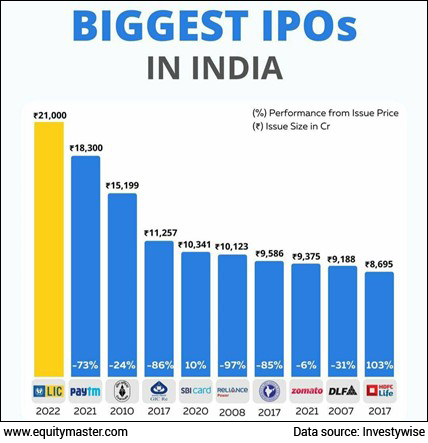India's Third Giant Leap
This Could be One of the Biggest Opportunities for Investors
- Home
- Views On News
- May 2, 2022 - LIC: Let's Invest Cautiously...
LIC: Let's Invest Cautiously...

Rajesh knows how to make your Mumbai sandwich experience count. He's been making sure of it for over 8 years now, on the footpath across our office.
It's a tough life, waking up at 5 am to prepare for the day which usually entails working for over 17 hours almost 365 days a year.
But Rajesh has always had a dream - to move from the street to his own licensed shop for which he has been saving all these years. But even so, it's not been enough.
Up until now or so he believes... last week, he opened a demat account to invest in the upcoming Life Insurance Corp of India (LIC) IPO.
Rajesh expects that he will make so much money in the IPO he would be able to finally start his own sandwich shop.
And just like Rajesh, thousands of investors have high hopes for this IPO, some of which may be quite misplaced.
The much-awaited issue of the state-run insurance behemoth is set to open on 4 May for subscription.
For many Indians, insurance is still synonymous with the LIC. Even today, "LIC karwayi" is commonly used as a synonym for purchased insurance in India.
With LIC IPO fever gripping the country, there are many investors who want to participate. There has been a surge in the number of demat accounts being opened by first time investors.
Remember the days when the much-sought-after Reliance Power mega IPO hit the market in 2008?
Brokers' offices were kept open day and night to facilitate investor subscriptions. However, the bitter aftertaste of that experience left many investors wary.
There is similar excitement with the LIC IPO. Of course, a striking difference is that LIC is a robust company with a very strong track record.
Even before the opening of issue, LIC is commanding a grey market premium of Rs 50-60, which is a decent premium for such a large issue.
In a good market environment, it is very likely the company may post good listing gains. Nevertheless, investors must be aware that the business of insurance is long-term in nature.
If we look past all the current hype and exuberance, the burning question is, will LIC deliver in the long term for its shareholders?

Launching In Chaos...
Analysts have questioned the timing of the IPO of Life Insurance Corporation. It will test India's capital markets at a time when about US$5 tn has been wiped out from global equities in recent months.After the revised pricing, LIC's cheaper valuations compared to peers is a positive for investors seeking listing gains. However, there are significant risks for long term investors.
Government Control and Potential Conflicts of Interest
One of the major concerns for long term shareholders is the company may sacrifice their interests to meet the goals set out by the government, its controlling shareholder.
LIC has admitted that at times its actions at the behest of the government could be contrary to shareholders' interest.
In recent years, LIC has been a key buyer of shares in state-owned firms sold off by the government, often bailing out less than successful public issues of shares.
In 2012, LIC bought 84% of shares on offer of the ONGC stake sale. In 2013, the insurance giant picked up over 70% in SAIL divestment.In 2015, LIC picked up almost half of the shares on offer in the Coal India's Rs 22,558 crore disinvestment, once again coming in to ensure success of a government stake sale.
And in 2018, LIC once again bailed out the initial public offerings of Bharat Dynamics Ltd and Hindustan Aeronautics Ltd.
LIC has also been roped in to rescue struggling financial institutions facing bankruptcy.
In 2019, it took over troubled IDBI Bank by infusing Rs 21,600 crore for a 51% stake using its policyholders' funds as the government struggled to find a viable buyer for the bank.
Over the years, LIC has also picked up stake in other state-run banks - Punjab National Bank, Corporation Bank, Allahabad Bank, and State Bank of India - as the government struggled to adequately capitalise these banks in line with the levels required by the RBI.
The government's dependence on LIC has been increasing over the last few years. The insurance behemoth has become the lender of last resort to the government.
LIC has invested Rs 10.7 lakh cr in the public sector since 2014 under the NDA government. In contrast, LIC's cumulative investment in public sector was Rs 11.9 lakh crore up to 2014.
In effect, the company has invested in public sector in just 7 years, 90% of the investments made in the previous 6 decades!
Some analysts are drawing parallels of LIC with Coal India which made its market debut in 2010. Despite being a monopoly, it has lost over half its value till date.
In 2014, about four years after it invested in Coal India, The Children's Investment Fund, a UK based activist hedge fund exited over concerns about what the majority shareholder was doing.
It's likely LIC could face similar resistance from shareholders. This does not bode well for long term valuations.
Competing with Private Insurers...
LIC is the fifth-biggest insurer in the world and assets under management (AUM) of LIC is over 3 times higher than all private life insurers combined.
Even then, the company has been consistently losing market share to private players. Currently, LIC holds 64% market share in terms of total life insurance premium.
But that is set to continue declining over the years. This is evident by the fact that it grew at a CAGR of 9% over the last 5 years while private insurers grew at over 18%.
Let's quickly understand how LIC operates. Up until 2021, 95% of the surplus generated by the company would be distributed amongst policy holders and 5% would be given to its single shareholder, i.e. the government of India.
| Old Method (Prior to Sept 2021) |
New Method (Post September 2021) |
|||||
|---|---|---|---|---|---|---|
| Life Fund % | INR | Life Fund (Participating %) |
INR | Life Fund (Non-Participating %) |
INR | |
| Surplus | 100% | 100 | 100% | 70 | 30% | 30 |
| Policyholders | 95% | 95.00 | 90% | 63.00 | 100% | 0.00 |
| Shareholders | 5% | 5.00 | 10% | 7.00 | 0% | 30.00 |
But the company changed this in September 2021 in line with other private players. Now LIC has split its Life fund, i.e., it's surplus funds into two categories - Participating policies (70%) and Non-Participating policies (30%).
Participating policies are those where bonuses are distributed. On the other hand, non-participating policies comprise of ULIPs and other guaranteed plans.
As per the new method, from the participating policies, 90% of this Rs 70 i.e., Rs 63 will be distributed to policyholders, and the balance Rs 7 will be available for shareholders.
Additionally, the entire share of Rs 30 from the non-participating policies will also be available for shareholders.
However, it is important to note that as compared to private players, this share of participating policies at 70% is still much higher. This means there is that much less available for the company's shareholders.
Let's look at some key financials metrics to see how LIC is doing compared to its peers.
| Particulars | SBI Life | HDFC Life | ICICI Prudential Life | LIC |
|---|---|---|---|---|
| Assets Under Management (Rs. bn) | 2,442.00 | 1,912.10 | 1,814.90 | 39,558.90 |
| Commission Ratio % | 3.50% | 4.40% | 4.20% | 5.50% |
| New Business % (Individual Agents) | 27.70% | 12.30% | 24.70% | 93.80% |
| Premium Growth CAGR% (2011-2021) | 14.50% | 15.70% | 7.20% | 7.10% |
| Value of New Business (VNB) Margin | 21.80% | 26.40% | 27.30% | 9.30% |
| Solvency Ratio | 2.12 | 1.9 | 2.02 | 1.83 |
| Persistency Ratio (13th month) | 84.50% | 85.90% | 85.00% | 78.80% |
If we look at the commission ratio, it is higher than private players. The percentage of new business brought in by individual agents is also exceptionally high at 93.8% compared to an average of just 22% among its peers.
This is because the company is very heavily dependent on agents for its sales. LIC's 1.36 million agents generate over 90% of premium income.
But over the last few years, the company has lost market share as it has been unable to capitalise on the digitalisation trend and woo investors who prefer buying online.
Between June 2020 and January 2022, LIC's market share fell from 74.04% to 61.4% in terms of premium income.
It is expected to continue losing market share as private players have established strong online channels. Just 36% of individual renewal premiums are collected digitally for LIC, compared to over 90% for private players.
Private players have quickly grown their market share as opposed to LIC's agents, who found it difficult to approach prospective customers amid lockdowns following the outbreak of the pandemic in 2020.
A persistently weak digital presence could keep costs high as agents typically receive high commissions.
Total expenses (including commissions paid to agents) for LIC has been steadily worsening from Rs 28,331.6 crore in FY19 to Rs 34,425.88 crore in FY2020 to Rs 35,162.21 crore in FY2021.
Another key parameter wherein LIC fares poorly is the Value of New Business Margin (VNB).
VMB measures profitability of new business written in a period. It is the present value of all future profits to shareholders measured at the time of writing a new contract.
The VNB margin of LIC is just 9.30% compared to the average margin of over 25% among its peers.
Compared to private insurers, the bulk of LIC's sales come through its savings and investment plans instead of pure insurance products.
This reduces the VNB margin because the company has to provide returns to policy holders of such savings plans as opposed to term insurance plans which are purely insurance products.
With more awareness and increased participation in the equity markets and mutual funds, investors are choosing to separate their insurance and savings requirements.
This has spurred a rapid growth in pure insurance plans. There may be less demand for investment & savings plans sold by LIC in the future.
Finally, if we look at persistency ratios, LIC has the lowest at 78.80% against the industry average of 85.13%.
Persistency ratio is the number of total policies an insurer has to the policies that are renewed or in force. It means lesser number of policyholders are choosing to renew their policies purchased from LIC.
Changing customer preferences and market trends for life insurance products may change. LIC doesn't seem to be in a position to respond appropriately or in time to sustain its business or market share in the future.
Insurance Stocks have Underperformed the Market...
As investors gear up for the mega initial public offering of Life Insurance Corporation of India, a niggling worry for them should be the lower appetite for stocks of insurance companies among investors.
Interestingly, none of the life insurance companies in India till date has seen a bumper listing. More importantly, none of these companies have really added significant gains since listing.
ICICI Prudential Life Insurance Co Ltd tumbled 11% on market debut in 2016. The stock which was issued at Rs 334 in September 2016 is currently trading at Rs 526, i.e. a CAGR of just 8.5% over the last 5 years.
HDFC Life Insurance Co Ltd listed with modest gains of 7% over its issue price in 2017. The stock has been in a down trend since September 2021 having fallen as much as 23% since then till date.
SBI Life Insurance Co Ltd, the country's largest private insurer listed with modest gains of just 5% on its debut. Trading at levels close to Rs 1,100 currently, the stock has grown at a CAGR of 10.5% since 2017.
Clearly, insurance stocks have underperformed over the last few years. This is not very encouraging for investors subscribing to the LIC issue.
Leaving Investors Confused?
Investors should carefully consider the risks before investing in the IPO. After all, life insurance is a fiercely competitive industry. Despite LIC being the market leader, it is competing with over 24 private companies which offer better service and are far more advanced in terms of technology.
The company has been losing market share consistently and this is expected to continue.
LIC has built a massive fund and an impressive renewal premium book over the last 66 years.
However, at some stage in the future, these advantages will go away and private players will catch up. An example of this is UTI, which had near monopoly in the mutual fund business. Today, UTI has been pushed to the eight slot in terms of assets under management as private players have taken the lead.
Another concern is that the company has to abide by the rules and regulations laid down by the government which puts limitations on the growth of the company.LIC is also sitting on a mark-to-market (MTM) loss of Rs 6,028 crore. In its draft papers, the company said of the Rs 11,265 crore worth of debt papers of mispriced insurance policies, papers worth Rs 5,351 crore are non-performing assets (NPAs).
Full provisioning has been done for these NPAs at an amortised cost. If this transaction is shown in the balance sheet, LIC would have to show a loss of Rs 6,028 crore.
It remains to be seen how LIC will adjust this MTM loss in its balance sheet.
Finally, the LIC IPO is set to be the biggest issue in the history of Indian markets.

If we look at the 9 biggest IPOs till date, surprisingly 7 of them have failed miserably with an erosion of as much as 97% of investors wealth in one case.
This track record is not a great precursor for the upcoming IPO. Investors should take note particularly given the lacklustre performance of several PSU offerings over the last few years.
Will all these factors dampen the LIC IPO? Will the stock list with significant gains? Will LIC be a winner in the long term?
We will just have to wait and watch...
In the meantime, do check out the below video by Co-head of Research at Equitymaster Tanushree Banerjee, where she explains how you should evaluate the LIC IPO.
Also, since you're interested in IPOs, check out the current IPOs and upcoming IPOs on our website.
Happy Investing!
Disclaimer: This article is for information purposes only. It is not a stock recommendation and should not be treated as such. Learn more about our recommendation services here...

Yazad Pavri
Cool Dad, Biker Boy, Terrible Dancer, Financial writer
I am a Batman fan who also does some financial writing in that order. Traded in my first stock in my pre-teen years, got an IIM tag if that matters, spent 15 years running my own NBFC and now here I am... Writing is my passion. Also, other than writing, I'm completely unemployable!


Equitymaster requests your view! Post a comment on "LIC: Let's Invest Cautiously...". Click here!
Comments are moderated by Equitymaster, in accordance with the Terms of Use, and may not appear
on this article until they have been reviewed and deemed appropriate for posting.
In the meantime, you may want to share this article with your friends!